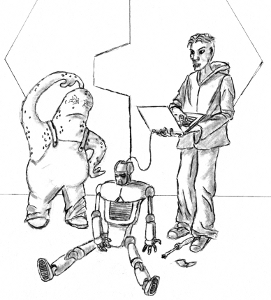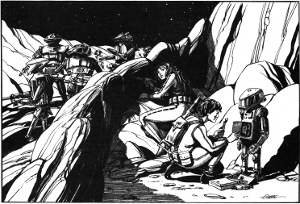by Tom Verreault
|
|
|
Robot… by Ashley Kursey at Deviant Art |
Robot Programming
In the Star Frontiers game few of the published modules featured robots and those that did failed to offer details on the robot’s mission or functions. Even in Dramune Run, where the Malthar had hundreds of attack robots, the players were never intended to fight them. This presented a feeling of robots being the forgotten technical field. In fact the Alpha Dawn rules explained how a robot was programed but did not give more than one example. Unless a referee was prepared to write up the Mission and Functions himself ahead of time, it became easy to ignore robots altogether.
This article will dig into the details of how a robot is programmed in game and will present a series of common mission and functions profiles. The purpose is to equip the referee to include robots, even if he does not feel up to writing the mission and functions himself, or if he’s including a robot on the fly.
In game there are three things that tell a robot what to do with itself: its programs, its mission, and its functions.
Programs
Programs are simple; they cover lots of details about the robots job that a referee or player would not want to deal with. For example a butler robot will have a service program that tells him how to fold towels, cut hair, press clothes, and hundreds of other details about a butler’s job but if the same butler robot was to also be a body guard as well, then he needs an attack/defense program or a restrain program to tell him about methods of fighting or details about weapons. If a referee is introducing a robot on the fly then he does not need to worry about what programs the robot has because it will have the programs that he needs it to have.
Missions
The mission is fairly simple as well; it simply tells a robot what its particular job is. Imagine a company that rents security robots to every mall in Port Loren. All of the robots have restraint programs to tell them how to apprehend shop lifters in a non-lethal manner as well as how to defend themselves and a law program that explains what the law code is and how to apply it. The mission tells him which mall to go to and what he should do there. For example one robot’s mission might be “patrol the public areas of the mall during the hours of operation and apprehend any law breakers and then return to base”. Another may have the mission: "Patrol the interior of the Frontier Firearms store for shoplifters." For each robot to perform a different job they will need to have a different mission.
Functions
The functions explain the key words in the mission. For example, the following mission has highlighted words and phrases that each require a function: “patrol the public areas of Central Mall during the hours of operation and apprehend any law breakers and then return to base”
Function 1 will tell the robot where Central Mall is and possibly include a map. Function 2 will explain public areas and/or include a diagram of the mall. Function 3 will list the hours of operation. Function 4 will define “base” as the company that rents the robot to the mall. No functions are required for how to apprehend as the restrain program covers multiple ways of doing that. Likewise the law program explains what the law is and when it’s broken.
Use in Play
So how could all of the above impact an adventure with player characters? Suppose that the players are looking for a diversion at a bar that has several armed individuals that may be aggressive with them. They state that they are looking around for anything interesting and ask, ”What do we see?” The referee states that several robots are leaving a security firm and splitting up to head in different directions and the players decide to follow one. The robotics specialist in the party makes some identification rolls and determines that these are simple security robots and he believes it’s very likely they are only programed for non-lethal combat. They decide to jump the robot as a group while the robotics specialist removes the security lock (which prevents the robot from being tampered with) and then deactivates it.
Once it’s deactivated this character lists the functions and mission and it's decided that he will redefine the functions. Function 1 is changed to identify the bar where they need the distraction as the mall. Function 3 is changed so that the hours of operation is now one specific hour that the players wish for the robot to create the distraction. Finally a new function is added defining a specific individual in the bar as a law breaker. The players preposition themselves believing that the robot, when reactivated, will travel to the bar at a specific time and attempt to apprehend a specific individual, and thereby give them their distraction. They are counting on this individual and his henchmen to shoot up the robot and they will then act, hoping most of the weapons carried by these non-player characters will be low on ammo.
It’s a good plan but it is clear in the rules that if a player programs a robot and is careless the referee should have the robot malfunction or follow literal instructions to the letter; particularly if that is contrary to what the players desire. The referee considers the changes in the functions and how they interact with the mission. Unfortunately, the players never considered function 2 that defined the robot’s patrol area as the public areas of the mall and included a diagram. Since the robot is fairly simple minded it does not know how to reconcile the diagramed public areas of the real mall with that of the bar so it consults its programing for the phrase “public area” and discovers in the law program that side-walks are considered public areas. So it travels to the bar and patrols the side walk outside of the bar.
This is not exactly what the players wished but it may still work for the distraction they desire. What is certain is that they will have to adapt and change their plans. Some discussion ensues where one player suggests that one of them enters the bar and asks who owns the robot but many of the individuals in the bar have met the player’s characters already and they will be on alert if a player character shows his face (hence the need for the distraction). Finally, they decide to call the bar and simply ask the bartender what’s up with the weird robot outside. The referee decides that the bartender will step to the door and be baffled by the robot calling his bar The Central Mall. He will then call it to the attention of the bar’s patrons. Once the NPC that is identified as a law breaker steps outside, the robot will recognize him as a law breaker and attempt to apprehend him. Now the players have their distraction as this character will not submit to being apprehended and he and his henchmen will shoot up the robot. The encounter is no longer inside the bar and occurs out on the street which is quite public so that while the robot gave them their distraction the situation is less than ideal as they now have to worry about law enforcement showing up sooner then they hoped.
As a referee I would have also allowed for the players to introduce a new line of code into the law program to classify anyone drinking alcohol as a law breaker which would also have given them their distraction if the robot had entered the bar. The Alpha Dawn rules don’t specifically allow for this but I would treat it as the same as modifying a function for a skill check.
Handling Robot Levels
The above is not the only consideration in reprograming robots. Robots have levels of sophistication. Robots of level 1 or 2 are fairly simple and lack the ability to speak. Robots over third level can speak but only level 5 and 6 can really think in a creative fashion. A level 6 robot is said to be able to write its own programing.
Because the robot in the above example was only level 3 (just smart enough to communicate verbally) it could not think creatively about its assigned patrol area in “public areas”. If it had been level 5 and almost certainly level 6 it may have reasoned that the public areas of the bar were inside but not the back rooms which would have caused it to enter the bar.
All robots level 4 and lower are very literal in how they follow their mission with level 1 and 2 robots being the most prone to malfunction due to conflicting programing. Level 5 and 6 robots have greater ability to think abstractly and creatively. Thus, missions and functions should be very explicit for the lower level robots while the highest level robots can handle simple and even vague missions being able to make judgment calls about their mission and functions.
Protocols and New Programs
New Programs
A referee can create a special robotics program for any robot, like the law program used in the above examples. The combat related programs on the equipment list get expensive but most programs a referee might make probably run about 500-1000 Cr based on their level of sophistication. A referee should compare his new program against those on the equipment list and make a judgment call. Some suggested programs include: Personal Grooming, Domestic Service, Cooking, Mining, etc.
Protocols
Protocols are basic instructions about everyday things that most robots can be assumed to have installed. For example; Frontier robots will need down time for maintenance and reboot of their processors to clear extraneous data. Rather than account for this in the mission and functions which would needlessly complicate them all or most Frontier robots have maintenance protocols which tell them when and where to shut down or to receive maintenance and these usually include who is authorized to perform maintenance. High level robots have these protocols but also have great flexibility in their decision making concerning shutting down or allowing maintenance.
Other protocols might be similar to Asimov’s famous laws of robotics barring a robot from harming a sapient being or allowing a sapient being to be harmed through inaction though this protocol is probably absent in combat robots. Finally, there may be a self-preservation protocol instructing the robot to avoid allowing itself from being damaged. These instructions are basic and widespread across the robotics industry. No skill roll is required to list them if the player asks, but to corrupt, rewrite, or delete them is difficult and the skill roll should have the same difficulty as the Alter Mission subskill.
Sample Missions and Functions
The following are some sample missions and functions by type of robot:
Maintenance Robots
Maintenance robots act as janitors and maintenance personal but without the ability to actually repair equipment. We can presume that there are hundreds of cheap maintenance programs that tell these robots how to sweep, mop, and change light bulbs but more importantly how to perform basic maintenance on equipment where they are employed. They usually have standard bodies and are limited to 4th level.
Sample Mission: Perform maintenance at X facility.
Function 1: The facility/location or equipment to be maintained must be defined. Maintenance is covered by the maintenance program.
Heavy Duty Robots
These robots are typically the size of a car and perform excavating, digging, or harvesting chores. They use heavy duty bodies and are limited to 4th level. They typically require direction for where and when to work and the agent that does this is labeled “foreman” or “supervisor” in its functions but this person can be a list of company employees authorized to give it direction, a robotic brain, or simply the owner. It may also require a program on harvesting or excavating that covers the details of these procedures.
Sample Mission: Dig/quarry/excavate at the direction of the foreman.
Function 1: The foreman is X. Everyone who is authorized to direct this equipment is listed in this one function.
Note: The foreman will need to be very explicit in his instructions and will likely need to closely monitor this robot.
Sample Mission: Harvest/plow/plant fields designated by owner.
Function 1: Defines the fields and could include a map
Function 2: Defines who the owner is or who the supervisor is in the case of a harvester shared between many farms.
Note: With defined fields of operation the farmer/owner will only have to tell the robot to harvest a specific field and he will not need to closely monitor the robot.
Combat Robots
Combat robots are employed as active combat soldiers by governments, mercenary bands, and occasionally criminal organizations. They use standard bodies, an Attack/Defense program, and are limited to 4th level.
Sample Mission: Take objectives assigned by higher authority or Follow orders given by higher authority.
Function 1: Defines who higher authority is. This could include a table of organization, rank chart with specified ranks considered higher authority, personal records of officers in the organization, or the designation number of a warbot.
Function 2: Technically objectives should be defined by a function but this word could be defined in a military program to keep things simple. Orders would need to be very simple like: “attack that vehicle” or “defend this location” and they would not require a function since the Attack/Defense program tells the robot what attack and defend means. However, an officer would do well to define for the robot what “this location” actually is, especially with low level robots.
Note: A combat robot will require a modified mission with more functions to be used as a guard at a military installation. One way around that is to pair the combat robot with a living individual that qualifies as “higher authority” who can give it orders.
Finally, a mission might include language that states, “and refuse all illegal orders.” This would require a function to define illegal orders.
Security Robots
Security robots serve as both guards and police. They are limited to levels 2-6, have standard robot bodies, and usually have the Restrain program for non-lethal attack and defense. A military might employ a security robot with an Attack/Defense program which would allow it to use deadly force.
Sample Mission: Guard/patrol the post/facility/ installation and apprehend unauthorized beings or law breakers.
Function 1: Defines the post, facility or installation and may include a map.
Function 2: May define the patrol area.
Function 3: Defines who is authorized. This could be anyone in uniform or with the proper ID displayed or include personnel records of everyone that is authorized. If the robot is to apprehend a law breaker then it will require a law program explaining what is breaking the law.
Note: the word apprehend will not require a function as the restrain program actually defines how to do this. The mission might also include language concerning raising an alarm or alerting police. If that is the case the robot will need to be equipped with a chronocom or have access to devices that will allow it to do this.
|
|
|
Robot. by Ashley Kursey at Deviant Art |
Service Robots
Service robots are servants, shop keepers, gardeners, and receptionists. They usually have anthropomorphic bodies matching the race they serve. They will have a program that supplies them with the details of their job like gardening, tailor, or customer service. These robots must be over level 3 so that they can communicate verbally.
Sample Mission: Using good customer service protocols, sell store merchandise to customers.
Function 1: Defines the store the robot works in.
Function 2: Defines the merchandise and may include numerous files on the actual merchandise.
Function 3: will define the customer as anyone not wearing a company uniform that walks into the store.
Sample Mission: Serve master as a butler/maid/ valet/servant.
Function 1: Defines the master and could include his immediate family.
Note: This robot is likely to have a butler, maid, or servant program that explains the details of its job. It is also likely that this robot is 5th or 6th level. There may be instructions for inserting understated sarcasm into its speech patterns or an actual personality matrix included in the butler program.
Warbot
These intelligent war machines are typically the size of a vehicle (heavy duty robot body) and must be level 5 or 6. They usually have Attack/Defense and Search and Destroy programs but could also have a computer link program. A sub category of this robot would be termination robots which use a standard or anthropomorphic body and are used to hunt and kill a specific individual or a list of targets.
Sample Mission: Defend location X from enemies.
Function 1: Defines what location X is and may include charts and maps.
Function 2: Defines who enemies are.
Note: the warbot may have a protocol that instructs it to avoid damaging property and harming non-enemies. If this is the case it may employ creative solutions to stopping enemies.
Sample Mission: Find and destroy X.
Function 1: Defines who or what X is.
Note: It is also likely that the mission will include language instructing the robot in what it should do once it has accomplished its mission. This would be the case with a limited kill list but if the mission was to kill all sathar the robot will hunt sathar until it ceases to function. It’s also possible that the mission might specify a location like a planet or city and that will require its own function.
Cybernetic Robots
These are specified to have mechanical and organic parts and may be built with any robotic body. The Alpha Dawn rules are quite vague on this so I generally consider a cybot to be a mechanical robot with a sapient brain. Hunter killer robots covered in living skin with blood vessels to pass as a sapient being like the terminator of the Terminator movie series would be another option. Lastly, organs for transplant might be shipped over interstellar distances installed in special transporter robots that have the machinery to keep that organ alive and functioning till it arrives at its destination. What the Alpha Dawn rules actually specify is that a cybot can perform any job performed by a robot of their level and thus it will have those missions and functions.
Cybernetic robots seem impractical to me but I could see a criminal leader keeping his enemies around as cybernetic robots with their brains installed in a mechanical body. What happens if the brain ever remembers who it used to be is easy to imagine in this case but it’s also easy to imagine a sociopath doing this.
Game Report - Example of Reprogramming a Robot
I recently received a game report of the adventure, “Mooks Without Number Part 1” (Frontier Explorer #1) that told of a creative way the players had reprogrammed a robot in that adventure.In this part of the adventure, there is a shot up heavy duty farming robot that the players reprogramed to aid in their defense of the farming village. Since the referee ruled it had a harvesting attachment, the players changed its functions to define wheat as any person standing outside the village. They further modified the robot to have a remote on/off switch and left it off till the pirates arrived at the village.
When violence ensued they turned on the robot and it began to attempt to “harvest” pirates standing outside of their vehicles. This quickly derailed the pirate’s attack plans during the encounter as the harvester started to chew through their ranks. And when the pirates broke and fled, the robot continued to chase those on foot across the countryside.
Conclusions
While robots are fairly common in the Frontier and appear in several of the published modules, very little detail is given as to their missions, functions, and programs to aid the referee in dealing with the robots presented. Hopefully, this article has provided some ideas and guidance that will aid Referees when including robots and characters with the robotics skill in their campaigns.





